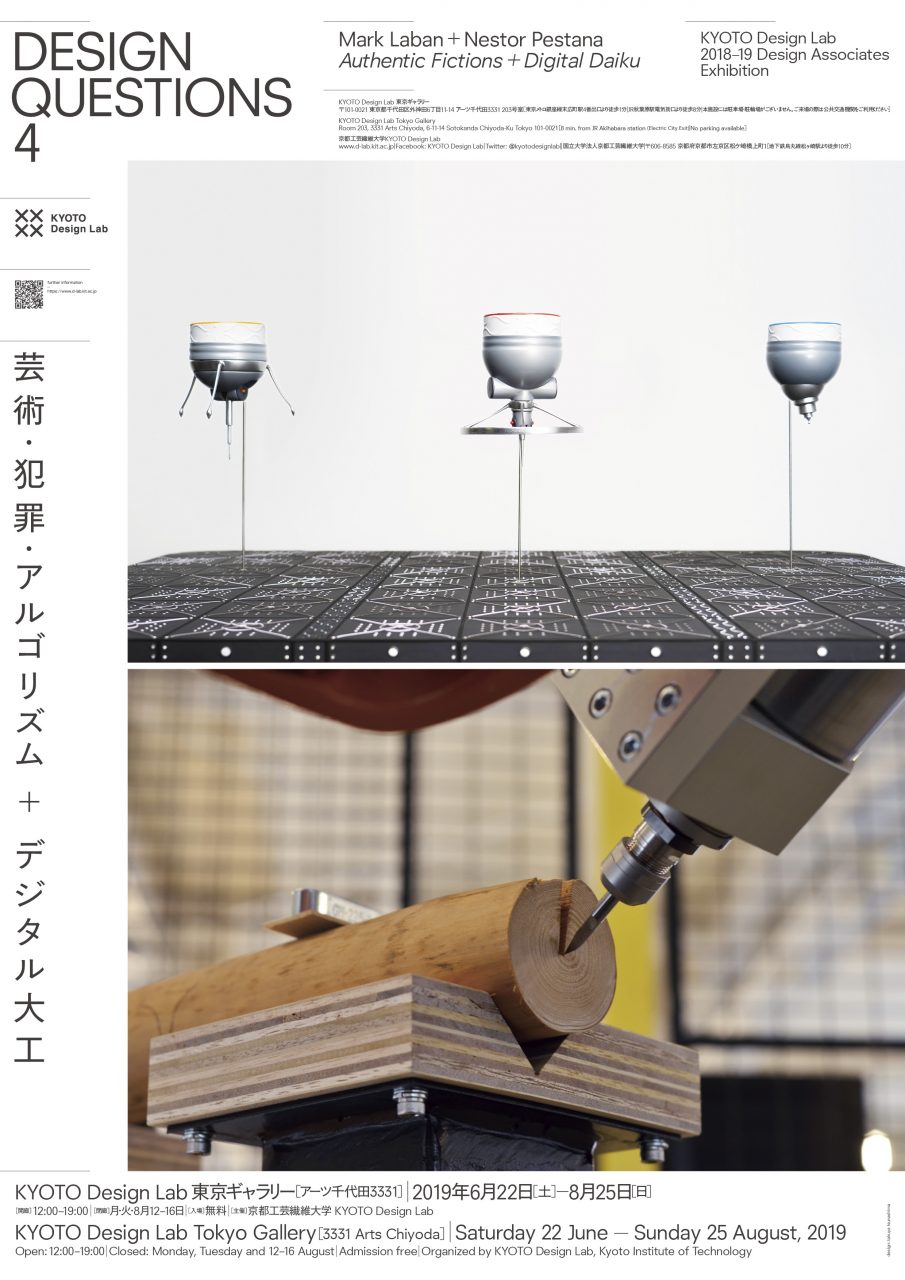京都工芸繊維大学 KYOTO Design Lab[D-lab]は、2018-19年D-labデザイナー・イン・レジデンス・プログラムとしてネスター・ペスタナ、マーク・ラバンと取り組んだ共同研究の展覧会「Design Questions 4 – 芸術・犯罪・アルゴリズム + デジタル大工」を開催いたします。
京都工芸繊維大学は、素材科学、繊維技術、工学、応用生物学における専門的研究において高い評価を得てきました。D-labデザイン・アソシエイト・プログラムは、海外の若いデザイナーを6ヶ月間招聘し、京都工芸繊維大学の教員陣との協働による学際的なデザイン研究をおこなうプロジェクトです。
デザインのイノベーションによって差し迫る社会問題に取り組み、学際的なプロジェクトにおいてデザインが果たす媒介としての役割を強調することで、京都工芸繊維大学の持つネットワークや研究の専門性を活かすことを目的とします。
本展では、D-labデザイン・アソシエイト・プログラムのうち、最近6ヶ月におけるふたつのプロジェクトを中心にご紹介します。D-labが掲げるテーマ「Designing Social Interactions──社会的関係性のデザイン」および「Making and Materials──つくる行為と素材の再定義」に基づき、ジュリア・カセム特任教授が主導しました。
ぜひご来場ください。

Design Questions 4
会期|2019年6月22日[土]−8月25日[日]
会場|KYOTO Design Lab 東京ギャラリー(アーツ千代田3331)[map]
開廊|12:00−19:00
閉廊|月・火・8月12−16日
入場|無料
主催|京都工芸繊維大学 KYOTO Design Lab
[プロジェクト解説+プロフィール]
ネスター・ペスタナ
芸術・犯罪・アルゴリズム ── 2.5Dプリンティングが描く未来
どのようにして、2.5Dプリンティング技術と画像修復アルゴリズムを組み合わせ、芸術作品の保存と鑑定、博物館学などの文脈で、新たなシナリオを想像することができるだろうか?
−
もし高解像度かつ安価に2.5Dプリンティングができるとするならば、どのようなシナリオが想像できるだろうか?
2.5Dプリンティングは、2Dと3Dの印刷の間に位置し、平らな表面に細かい凹凸のテクスチャーを高解像度でカラー印刷する技術である。現在この技術は、視覚障害者のための教材やテクスチャーのプロトタイピングなど、限られた応用法しか提示されていない。また、現時点ではある特定のサイズでしか印刷することができない。これらの制約は、高解像度のスキャンデータと同等レベルの解像度で正確なレプリカを印刷することができないという技術的な課題に由来している。この課題が解決されれば、科学などの精密さが求められる分野での応用可能性が広がっていく一方で、芸術作品の偽造のような目的に悪用されることも考えられる。
Casioなどの企業の研究チームは、スキャンと印刷の解像度の不一致や、印刷されたテクスチャーの解像度の向上などの課題に取り組んでいる。本プロジェクトは、これらの課題が乗り越えられた未来でどのような応用法が考えうるかを模索する。同時に、印刷解像度を上げるために役立つ技術を示唆し、そこから派生しうる多様なシナリオを提示する。
ネスター・ペスタナ
Nestor Pestana(http://nestorpestana.co.uk/)
ポルトガル出身。英国王立芸術学院のデザイン・インタラクションにて修士号を取得。スペキュラティヴ・デザイナー、マルチメディア・アーティストとして現在ロンドンを拠点に活動している。科学とデザインとテクノロジーの繋がりを模索しながら、領域横断的でコラボレイティブな作品を制作し、イギリスやその他諸外国にてセミナー、ワークショップ、講演などの活動も行なっている。彼のプロジェクトは、映像、イラストレーション、インスタレーションなど様々なメディアによって表現される。最近の展示ではロンドン・カレッジ・オブ・ファッションにおけるPlumial Space、ヴェネチア・ビエンナーレ国際建築展におけるSchool of Tomorrowなどがある。
マーク・ラバン
デジタル大工 ── 伝統木工加工技術の再解釈
-
日本の伝統的な建具加工技術と知識は、どのようにしてデジタル製造技術と連携し、新たなプロダクトを生み出すことができるだろうか?
−
特定の文化的意味や活用法を持つ北山杉のような素材は、どのようにして再解釈され、他のデザインの文脈において活用されうるだろうか?
本プロジェクトは、昨今のふたつの問題に言及している。デジタル時代以前に技術を磨いた宮大工達は高齢化しており、彼らの持つ何世代にもわたって培われた暗示的な知識は、デジタルフォーマットへ変換されなければ消滅してしまう危機に面している。同様に、日本の伝統的な建具に関する知識を持たない新しい世代の職人達は、この知識を保存し新たなデザインの文脈において活用するために、デジタル製造技術の活用法を理解する必要がある。
また、北山杉のような伝統的な素材においてよく見られる問題として、それらの製造を支える知識や技術は、特定の文化的文脈に閉じ込められていて、新しいデザインの活用法が見出されない限り失われてしまう。本プロジェクトは、北山杉をデジタル製造技術によって一変させることで、現代の新しい文脈の中に位置づけ、デジタル製造技術が凹凸のある形の素材の加工に多大な貢献をもたらす可能性を示している。
マーク・ラバン
Mark Laban(http://www.marklaban.com)
2016年にセントラル・セント・マーチンズにて家具デザインの修士号を取得。CNC技術の専門家であり、デジタル製造技術を用いて伝統的な工芸と現代の工芸を架橋する作品を制作している。デジタル時代における工芸の意味を問い、それが近い将来にどのように変化していくのかを考えることを目的としている。ロンドンを拠点として活動しており、最近の作品はロンドンのAram Galleryにて展示されている。Rustic Stool 1.0が2017年のWood AwardsにてStudent Prizeを受賞。
KYOTO Design Lab [D-lab] will hold the Exhibition “Design Questions 4” in KYOTO Design Lab Tokyo Gallery.
The Kyoto Institute of Technology is known for its research excellence in materials and fibro science and engineering and applied biology.
For the D-lab Design Associate Programme, a young designer from abroad or within Japan is invited to work for six months in collaboration with a KIT team on a research question for which design can provide a new approach and applications.
The aim is to harness KIT’s research expertise and external networks using design innovation to address pressing social issues and underscore the key mediating role design can play in interdisciplinary projects.
This exhibition centres on two recent six month-long projects from the D-lab Design Associates Programme. They fall within Kyoto D-Lab’s Designing Social Interactions and Making and Materials themes and were initiated and led by Professor Julia Cassim.
Design Questions 4
Period: Saturday 22 June – Sunday 25 August, 2019
Venue: KYOTO Design Lab Tokyo Gallery [3331 Arts Chiyoda] [map]
Open: 12:00-19:00
Closed: Monday, Tuesday and 12-16 August
Admission free
Organized by KYOTO Design Lab, Kyoto Institute of Technology
[Works + Profiles]
Nestor Pestana
Authentic Fictions: speculative futures for 2.5D printing
How can the new 2.5D printing technology be used in combination with other technologies such as image in-painting algorithms, to imagine new and future scenarios, in relation to conservation, museology and fraud?
−
If 2.5D printing technologies could print in extremely high resolution and be commercially available at low cost,what scenarios could be imagined?
2.5D printing can be defined as low-relief textured printing delivered on flat surfaces with stable high resolution colour. It sits between 2D and 3D printing, hence it’s name. The technology is currently being used in a fixed size format for a limited number of applications, such as for the production of educational materials for visually impaired people and the creation of textured surfaces for the prototyping industry. These limitations are mainly due to the fact that the technology cannot print accurate replicated textures derived from high-resolution scanned data with the same degree of resolution. Were this possible, it could potentially open a whole range of applications to meet the demands of more rigorous and scientific industries as well as opening the doors to its misuse in certain areas such as fraudulent fine art ‘originals’.
Research groups such as that at Casio are currently exploring how to overcome this resolution mismatch between scanning and printing and increase the resolution of the textures provided by 2.5D printing. This project seeks to explore what applications could arise from these developments in plausible futures. It indicates at the same time, the kind of technologies that might allow an increase of the required print resolution, and the diverse scenarios that might arise from these developments.
Nestor Pestana (http://nestorpestana.co.uk/)
Nestor Pestana is an award-winning speculative designer and multi-media artist based in London. His work is collaborative and multidisciplinary, exploring the links between science, design and technology to promote the distribution of knowledge, critical thinking and lifelong learning. His work straddles graphics, animation, interaction and exhibition design. His first degree was in conservation and restoration from the Polytechnic Institute of Tomar followed by a 1st Class Honours Degree in Design from the University of Aveiro, Portugal. He received an MA in Design Interactions with distinction from the RCA in 2015.
Mark Laban
Digital Daiku: reimagining Kitayama Sugi in a digital fabrication world
How can Japanese traditional joinery skills and knowledge inform digital fabrication methods so that they can work in tandem to enable new product iterations?
−
How can materials like Kitayama Sugi with specific cultural meanings and contextual uses be reinterpreted for use in other design contexts?
This project seeks to address two current issues. The generation of temple carpenters who acquired their skills in a pre-digital age is a rapidly ageing one. It means that their implicit materials-based knowledge built up over generations is in danger of being lost, unless it can be translated to inform digital formats so that the two work in tandem. Similarly, a new generation of craftspeople untrained in Japanese traditional joinery skills will need to understand how to harness digital fabrication techniques to preserve, translate and extend knowledge of them for new design contexts.
The second issue is one common to traditional materials such as Kitayama sugi that are trapped in a fixed cultural context of use in a world where their survival and the knowledge and skills that underpin their production depend upon new design uses being found for them. By transforming this material with the aid of digital fabrication techniques, the project aims to present it in a new contemporary context and display the strengths that digital and robotic fabrication can bring to the use of a non-standard variable material like Kitayama sugi.
Mark Laban (http://www.marklaban.com)
Mark Laban graduated from Central Saint Martins, University of the Arts London with a BA in Fine Art and in 2016 with an MA in Design specialising in furniture. A CNC specialist, his work brings together traditional and contemporary craft through the language of digital manufacturing technology. His aim is to question what craft can mean in the digital age, and where it could be heading in the near future. Based in London, Mark’s recent work has been exhibited in London’s Aram Gallery, and his ‘Rustic Stool 1.0’ was selected as winner of the Wood Awards student/graduate designer category in 2017.